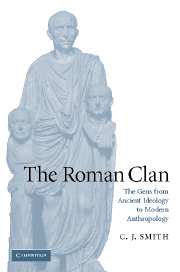Book contents
- Frontmatter
- Contents
- List of illustrations
- Preface
- List of abbreviations
- General introduction
- Part I THE EVIDENCE FOR THE GENS
- Part II TOWARDS AN INTERPRETATION OF THE GENS
- Chapter 5 The Roman community
- Chapter 6 The Roman curiae
- Chapter 7 The patricians and the land
- Chapter 8 The patriciate
- Chapter 9 Warfare in the regal and early Republican periods
- Chapter 10 Explaining the gens
- Chapter 11 Roman history and the modern world
- Appendix 1 Dionysius of Halicarnassus on the Roman curiae and religion
- Appendix 2 The missing curiae
- Select bibliography
- General index
- Index of ancient persons
- Index of passages discussed
Chapter 5 - The Roman community
Published online by Cambridge University Press: 22 September 2009
- Frontmatter
- Contents
- List of illustrations
- Preface
- List of abbreviations
- General introduction
- Part I THE EVIDENCE FOR THE GENS
- Part II TOWARDS AN INTERPRETATION OF THE GENS
- Chapter 5 The Roman community
- Chapter 6 The Roman curiae
- Chapter 7 The patricians and the land
- Chapter 8 The patriciate
- Chapter 9 Warfare in the regal and early Republican periods
- Chapter 10 Explaining the gens
- Chapter 11 Roman history and the modern world
- Appendix 1 Dionysius of Halicarnassus on the Roman curiae and religion
- Appendix 2 The missing curiae
- Select bibliography
- General index
- Index of ancient persons
- Index of passages discussed
Summary
INTRODUCTION
In the next section of this book, consideration of the political context in which the gens is supposed to have played a role is my theme. In this introduction, I give a brief account of the historical framework, preceded by a discussion of two key issues, the nature of clientela or the patron–client relationship in early Rome, and the issue of the identification of the plebs. It should be made very clear that every point in this reconstruction has been the subject of much debate, and my reconstruction is not the same as that of others. Many parts of this reconstruction are discussed in much greater detail later, but a broad statement of the sequence of events, and some of the positions I take, will, I hope, be helpful at this stage. For a statement of the problems with the sources, I refer readers back to the General introduction.
CLIENTES AND PLEBEIANS
The ancient tradition makes the first constitution of Rome the work of Romulus. It is noteworthy that the foundation of the city was accompanied by an act of constitutional creation, and it is, of course, literally incredible that we have reliable details here. First, many such constitutional moments are described in the sources for ancient city states, and all betray signs of later invention. Second, Romulus himself is almost certain to be an invented founder.
- Type
- Chapter
- Information
- The Roman ClanThe Gens from Ancient Ideology to Modern Anthropology, pp. 168 - 183Publisher: Cambridge University PressPrint publication year: 2006

